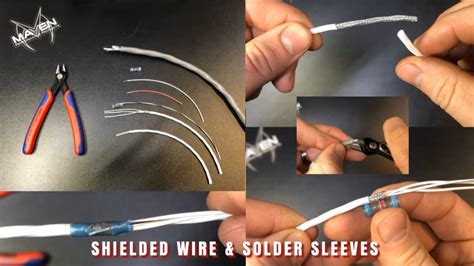How To Ground Shielded Wire
Ronan Farrow
Mar 31, 2025 · 4 min read

Table of Contents
How to Ground a Shielded Wire: A Comprehensive Guide
Grounding a shielded wire is crucial for protecting sensitive electronic equipment from electromagnetic interference (EMI) and radio frequency interference (RFI). A properly grounded shield ensures signal integrity and prevents damage. This guide provides a step-by-step approach to effectively grounding your shielded wire, regardless of your experience level.
Understanding the Importance of Grounding
Before diving into the practical steps, let's understand why grounding a shielded wire is so vital. The shield, typically a braided or foil layer, acts as a Faraday cage, diverting unwanted electromagnetic fields away from the inner conductor carrying your signal. Without a proper ground connection, this shield is essentially useless. The interference can corrupt your signal, leading to data loss, malfunctioning equipment, or even permanent damage.
Key Benefits of Proper Grounding:
- Reduced Noise: Grounding significantly reduces unwanted noise and interference in your signal.
- Improved Signal Integrity: A clean signal ensures reliable data transmission and operation.
- Equipment Protection: Grounding protects your sensitive electronic devices from potential damage caused by surges or electromagnetic fields.
- Compliance with Standards: Many electronic applications require proper grounding to meet safety and regulatory standards.
Methods for Grounding Shielded Wire
There are several effective ways to ground a shielded wire, depending on the application and your setup. The most common methods include:
1. Grounding at One End
This is the simplest method, ideal for shorter cable runs where minimizing ground loops is less critical. The shield is connected to ground at only one end of the cable. This prevents ground loops, which can introduce noise into your signal. However, it offers less effective shielding compared to other methods.
Steps:
- Identify the ground point: This could be a chassis, a ground terminal on your device, or a designated grounding point in your system.
- Strip the outer jacket and shield: Carefully expose the shield at the appropriate end of the cable, ensuring you don't damage the inner conductor.
- Connect the shield to ground: Use a suitable connector or crimp terminal to securely attach the shield to your ground point. Ensure a good, low-resistance connection.
2. Grounding at Both Ends
This method provides better shielding and is often preferred for longer cable runs or applications requiring higher levels of protection against EMI/RFI. The shield is grounded at both ends of the cable. While this may introduce the possibility of ground loops, the improved shielding often outweighs this risk. To minimize ground loop issues, ensure both ground points have low impedance and are at the same potential.
Steps:
- Identify the ground points: Find suitable grounding points at both ends of the cable.
- Strip the outer jacket and shield at both ends: Expose the shield at both ends, being careful not to nick the inner conductor.
- Connect the shield to ground at both ends: Use appropriate connectors or crimp terminals to secure the shield to ground at both ends.
3. Grounding with a Grounding Braid
For extremely sensitive applications or where maximum shielding is paramount, consider using a grounding braid in addition to grounding the shield at one or both ends. A grounding braid runs along the entire length of the cable, providing additional protection against EMI/RFI.
Steps:
- Secure the braid to the shield: Wrap the grounding braid around the shielded cable, ensuring proper contact along its entire length.
- Ground the braid at one or both ends: Connect the braid to ground using appropriate connectors or crimp terminals.
Choosing the Right Method
The best grounding method depends on your specific needs and the characteristics of your application. Consider the following factors:
- Cable length: Longer cables generally benefit from grounding at both ends or using a grounding braid.
- Sensitivity to EMI/RFI: Highly sensitive applications may require grounding at both ends or a grounding braid.
- Ground loop susceptibility: Be mindful of the potential for ground loops when grounding at both ends.
- Environmental factors: Consider the presence of strong electromagnetic fields or other sources of interference.
By carefully following these steps and choosing the appropriate grounding method, you can ensure the effectiveness of your shielded wire and protect your valuable equipment. Remember to always prioritize safety and use appropriate tools and techniques.
Featured Posts
Also read the following articles
| Article Title | Date |
|---|---|
| How To Get Stains Out Of Scrubs | Mar 31, 2025 |
| How To Get The Swelling Down After Wisdom Teeth Removal | Mar 31, 2025 |
| How To Defoliate Cannabis | Mar 31, 2025 |
| How To Flush Meth Out Of System | Mar 31, 2025 |
| How To Get Motivation To Play Guitar | Mar 31, 2025 |
Latest Posts
-
How To Sanitize Pool After Dead Animal
Apr 02, 2025
-
How To Sanitize Mead Equipment
Apr 02, 2025
-
How To Sanitize A Dryer Without Bleach
Apr 02, 2025
-
How To Sand Crown Molding
Apr 02, 2025
-
How To Run For City Council In California
Apr 02, 2025
Thank you for visiting our website which covers about How To Ground Shielded Wire . We hope the information provided has been useful to you. Feel free to contact us if you have any questions or need further assistance. See you next time and don't miss to bookmark.
